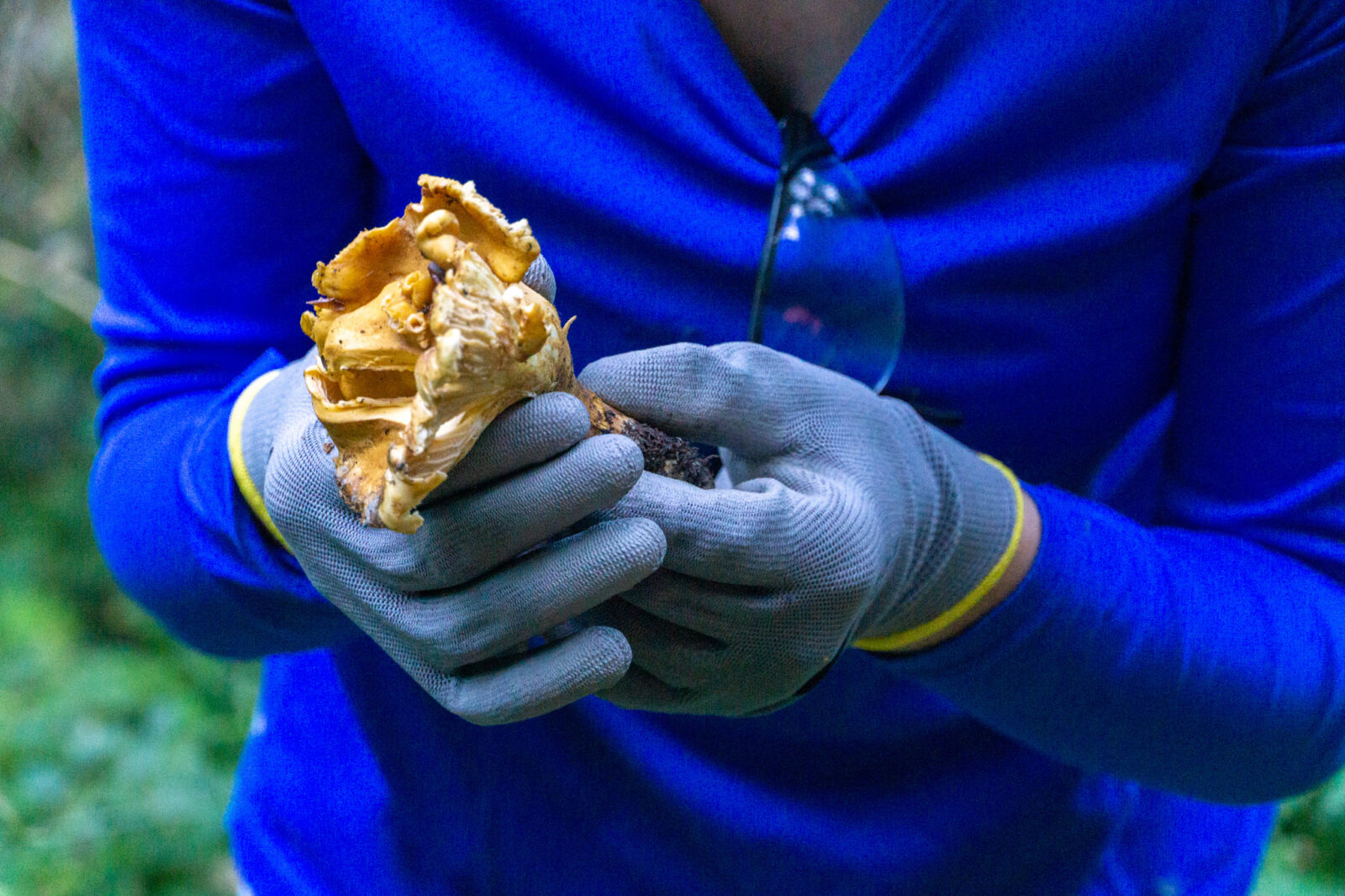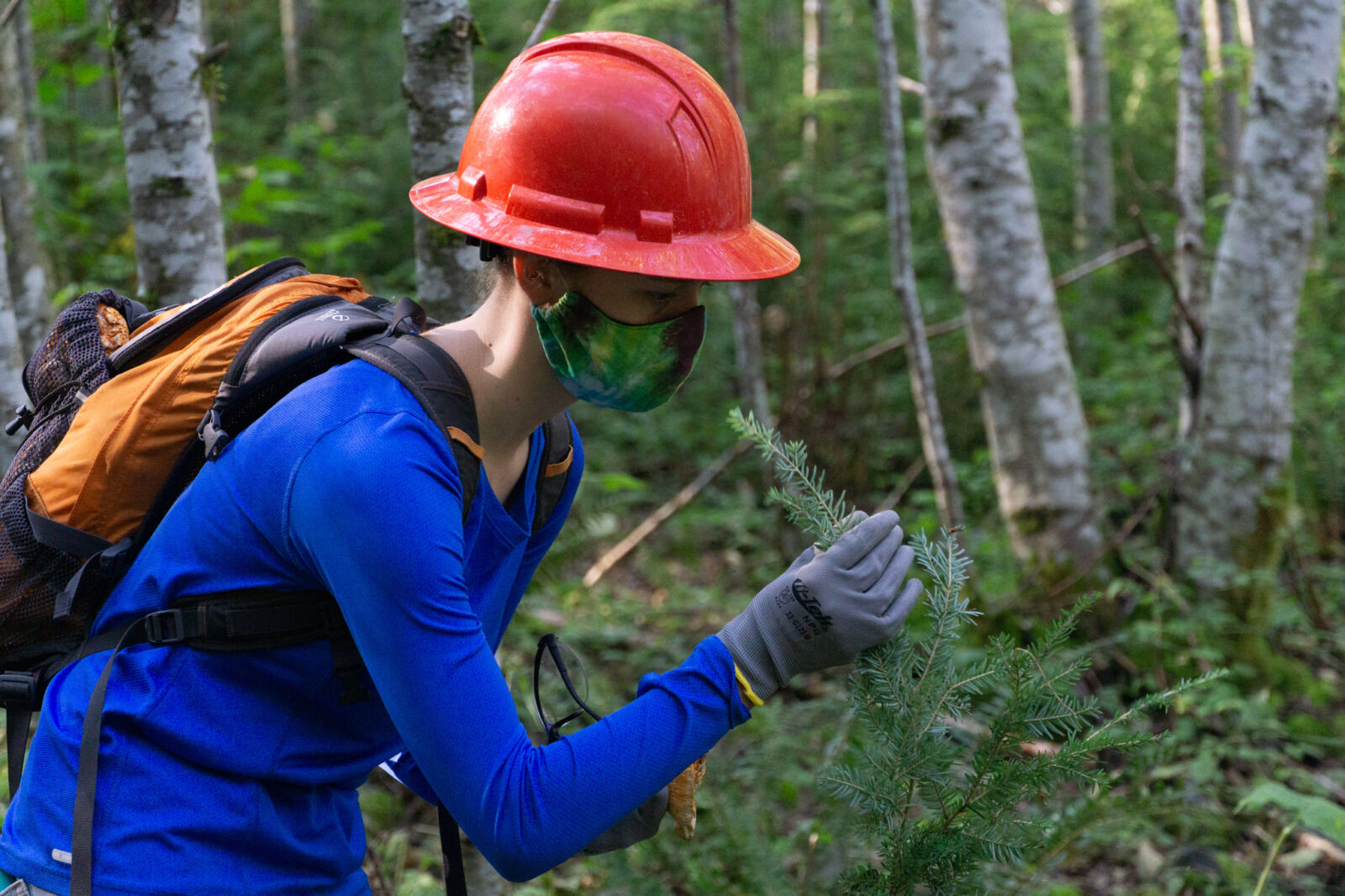Shayla Henry holds out a red-tinged fungus she’s harvested off the forest floor. “It’s a lobster mushroom!” she says.
It’s an early October morning on the Squire Creek Trail, 90 minutes north of Seattle, in the Mt. Baker-Snoqualmie National Forest. A few years ago, fungi foraging wasn’t even on 18-year-old Henry’s radar. Now she can identify several species of mushrooms, trees, ferns, and berries, and wants to pursue a career outdoors. That shift is thanks to the Glacier Peak Institute (GPI), a nonprofit based in the former logging town of Darrington, Washington, that hires local teenagers to build campgrounds, clear trails, and learn about forest management. Henry’s GPI summer season is over, but she’s volunteering today while visiting home, and is teamed up with another crew employed for the season.
GPI’s executive director, Oak Rankin, grew up in Darrington, population 1,400, and spent his 20s and early 30s traveling the world. Things changed for Rankin after a 2014 landslide killed 43 people in Oso, 20 miles east of his hometown, and buried a mile of State Route 530, isolating Darrington for weeks. He’d already been feeling frustrated and helpless about the poverty, limited opportunity, and underfunded schools plaguing his childhood home.
I have seen classmates die from suicide, driving under the influence, homicide, overdoses and falling asleep at the wheel. [The landslide was] like a cherry on top of the sundae in the destruction of [my] community.”
Through GPI, he aims to change all of that. Named after an active volcano southeast of Darrington, the organization works with local schools and other partners including the National Forest Foundation to bring science education and outdoor adventure to local youth. The goal is to empower them to build a resilient community and environment.
“We’re trying to save lives and ecosystems,” Rankin said.
Darrington has a grocery store, a gas station, thrift shops, and a burger joint, but job openings are rare. Plus, transportation can be an issue for many kids, Henry said, and GPI offered van rides to and from trailheads (a practice the pandemic has paused). The program helped Henry see how her choices affect her future, something she’d never considered.

Photo by Colleen Stinchcombe
Shayla Henry holds a mushroom.
Henry’s crew was funded primarily by the NFF’s Treasured Landscapes, Unforgettable Experiences program, which helps a selected National Forest accomplish its goals each year. Starting in 2020, the program will provide over $2 million worth of funding and project management to the 540,000-acre Darrington District in the Mt. Baker-Snoqualmie. Known for its glaciated peaks and old-growth forests, this spectacular region is home to threatened river runs for steelhead and salmon, and is the ancestral land of tribes including the Stillaguamish, Tulalip, Sauk-Suiattle, Upper Skagit, and Swinomish.
The Darrington Ranger District, which receives heavy use from Seattle and Everett, was a clear place to focus in part because of the Mountain Loop Highway. This National Scenic Byway on the west side of the Cascade Range is a partially-paved 55-mile road connecting Darrington to Granite Falls. It provides access to popular sites including the ice caves at Big Four, the crystal-clear alpine waters of Lake Twenty-Two, and the Boulder River’s year-round waterfalls. More than 275,000 visitors access the highway each year, and visitation is growing.
Michael Schlafmann, Public Services Staff Officer for the Mt. Baker-Snoqualmie National Forest, said the District hasn’t seen much recreational improvement for over a decade. Most of the highway was built for logging, or during an era when trailheads saw only 20 cars on busy weekends, but now some trails see nearly 40,000 summer visitors. The trails themselves get pummeled by the sheer number of feet, causing erosion as people wander off-path. “They’re not really functioning in the current climate,” Schlafmann said.
With projects slated in the Darrington District through 2025, the NFF will help address many of these issues through its own work, as well as through partnerships with nonprofit organizations and local tribes. In addition to GPI, the NFF will partner with the environmental leadership program EarthCorps to improve recreation areas. It also anticipates working with the Stillaguamish Tribe and the Tulalip Tribes to restore culturally-significant species including elk and huckleberries. This is one of this Treasured Landscapes project’s main goals: to diversify and increase the number of people stewarding the land.

Photo by Colleen Stinchcombe
Shayla Henry identifying a young tree.
Henry and the crew of GPI teens are living, walking, trail-clearing proof that progress toward that last goal is already underway. After a mid-morning break, their crew leader Christaldo Rodriguez, 24, quizzes the teens on tree and berry species. Henry is full of both questions and answers. Rankin, who joined the crew for the morning, helps her identify chanterelles, milk caps, and oyster mushrooms.
The group hikes farther to the site of a smaller 2013 landslide. Dizzying stripes of white-barked alder trees offer a break from the dense forest, the warm yellow of autumn light trickling through. Rankin tells the group these trees are one of the first species to populate a disturbed area. A symbiotic relationship with bacteria in their root nodules means they can capture nitrogen from the air, pulling it back into the ground, in time allowing other species to grow. As proof, surrounding the group are patches of sword fern, red cedar, and Douglas-fir saplings blooming in the undergrowth.
Rodriguez wants the kids to relate the forest to their lives—to make the forest personal. “I see myself as one of these young trees, with barely enough nutrients to get by,” he says.
Henry chimes in. “It sounds like you’re saying you can’t blame yourself if you don’t have the right environment to grow.”
Rankin hopes to help GPI’s participants solve these problems, and tells them about careers in wildland firefighting, forest management, recreational guiding, science, fisheries, and Forest law enforcement. Henry says she still gets emails from him with job ideas. One former crew member went on to study agroforestry at Western Washington University, and Henry hopes to follow a similar path. In 2019, she joined Job Corps, a live-in educational and vocational training program run by the U.S. Department of Labor. She specifically sought a location offering a forestry conservation and wildlife firefighting curriculum. Between the pandemic and a knee injury, she’s spent the last few months at home, but she’s keen to return.
“I know I want to be outdoors, but what do I want to pursue outdoors?” she says. “I'm eager to keep learning about it.”
About the Author
Colleen Stinchcombe is a writer and photographer covering the environment, health, and outdoor recreation. She lives in Edmonds, Washington. Find her at colleenstinchcombe.com.

